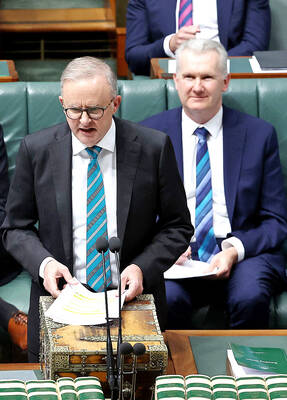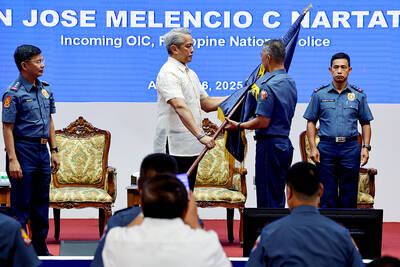It is a brutal 600km gauntlet during which competitors face searing heat, wild seas, vicious predators and the threat of kidnapping. Only one in 10 are likely to finish. This is the Mc Arthur National Race — the Philippines’ longest homing pigeon race. It is a tough challenge for the birds and a tense affair for the owners.
“Compared to Europe and the United States, we have lots of predators here and a lot of people who shoot these birds,” said Jaime Lim, 68, one of the Philippines’ best-known pigeon fanciers — as the pursuit’s devotees are known.
“Fishing nets are set up in the mountains to capture these birds. That’s a major problem nowadays,” the construction magnate added.

Photo: AFP
Racing pigeons can be worth thousands of US dollars, but some that are kidnapped are sold off to unscrupulous fanciers for as little as US$14, Lim said.
It is a nefarious side effect of the hobby’s swelling popularity in the Philippines, where there are now at least 300 clubs with thousands of members.
This mirrors increasing popularity in other Asian countries, particularly India, Taiwan and China.
In March, a Chinese buyer spent a record 1.25 million euros (US$1.4 million) at an auction for Belgium’s best long-distance racing pigeon of all time.
According to Encyclopedia Britannica, the sport began in Belgium, where the first long-distance race was held in 1818. The European nation remains the global hub for enthusiasts.
The appeal in the Philippines seems to be a mix, including the bird’s fascinating navigational skills and a touch of hunger for a quick profit.
Fancier Mary Grace San Jose, 38, is from the poor district of Tondo in Manila and said one draw is that racing is open to everyone.
“What is important is you are able to feed them,” she said, adding: “You may not afford what the rich give their birds ... but that’s fine.”
Money remains part of the appeal for many, though.
“It does not look good, but the opportunity to gamble is part of it,” said Eddie Noble, an official of the 1,000-member Metro Manila Fanciers Club.
However, Noble said that the main driver is the excitement of “racing these birds with a phenomenal ability to find their way home.”
Science has never explained the homing pigeon’s skills.
The two more popular theories posit that they follow the Earth’s magnetic field lines and rely on their sense of smell.
One new hypothesis says that the birds use ultra-low frequency sounds that map out the terrain.
That ability is put to the test in the race.
“Ten percent, at the most, make it back,” race director Nelson Chua said of the event, which begins in MacArthur on the island of Leyte.
“We can say that 50 to 70 percent were snared by nets, shot, or taken by predators,” he said.
Lim said that secrecy is necessary to protect the birds: “If they [kidnappers] get wind of the date of the race that’s when they put their nets up.”
Most of the rest are picked off by predator birds, felled by tropical heat and exhaustion, or even the occasional typhoon in a competition that lasts at least 10 hours.
Those that survive fly to their coups in the Manila area. Their owners must then retrieve a code affixed to the pigeon’s foot and call it in to race organizers, which is how finishing order is determined.
For Ashley Fruno, a campaigner for People for the Ethical Treatment of Animals, the three sea crossings in the race, rather than poachers, are to blame for the 90 percent casualty rate, which she said is among the world’s deadliest.
“There’s nothing sporting about forcing animals to risk — and often lose — their lives so that someone can win a prize, a title or some money,” Manila-based Fruno said.
She added that the pigeons fly low over water to avoid wind, and so many die when hit by waves or succumb to exhaustion.
Fanciers say they wait for their birds like worried parents.
“It might take a few days, but they always come back unless they are caught by net,” San Jose said.
“If they don’t, I’ll spend days at their rooftop loft, waiting for them,” she added.
Yet she conceded that she has no idea what happened to her last two entries in the race.

ANGER: Unrest worsened after a taxi driver was killed by a police vehicle on Thursday, as protesters set alight government buildings across the nation Protests worsened overnight across major cities of Indonesia, far beyond the capital, Jakarta, as demonstrators defied Indonesian President Prabowo Subianto’s call for calm. The most serious unrest was seen in the eastern city of Makassar, while protests also unfolded in Bandung, Surabaya, Solo and Yogyakarta. By yesterday morning, crowds had dispersed in Jakarta. Troops patrolled the streets with tactical vehicles and helped civilians clear trash, although smoke was still rising in various protest sites. Three people died and five were injured in Makassar when protesters set fire to the regional parliament building during a plenary session on Friday evening, according to

‘NEO-NAZIS’: A minister described the rally as ‘spreading hate’ and ‘dividing our communities,’ adding that it had been organized and promoted by far-right groups Thousands of Australians joined anti-immigration rallies across the country yesterday that the center-left government condemned, saying they sought to spread hate and were linked to neo-Nazis. “March for Australia” rallies against immigration were held in Sydney, and other state capitals and regional centers, according to the group’s Web site. “Mass migration has torn at the bonds that held our communities together,” the Web site said. The group posted on X on Saturday that the rallies aimed to do “what the mainstream politicians never have the courage to do: demand an end to mass immigration.” The group also said it was concerned about culture,

Australia has announced an agreement with the tiny Pacific nation Nauru enabling it to send hundreds of immigrants to the barren island. The deal affects more than 220 immigrants in Australia, including some convicted of serious crimes. Australian Minister of Home Affairs Tony Burke signed the memorandum of understanding on a visit to Nauru, the government said in a statement on Friday. “It contains undertakings for the proper treatment and long-term residence of people who have no legal right to stay in Australia, to be received in Nauru,” it said. “Australia will provide funding to underpin this arrangement and support Nauru’s long-term economic

Philippine President Ferdinand Marcos Jr has fired his national police chief, who gained attention for leading the separate arrests of former Philippine president Rodrigo Duterte on orders of the International Criminal Court and televangelist Apollo Carreon Quiboloy, who is on the FBI’s most-wanted list for alleged child sex trafficking. Philippine Executive Secretary Lucas Bersamin did not cite a reason for the removal of General Nicolas Torre as head of the 232,000-member national police force, a position he was appointed to by Marcos in May and which he would have held until 2027. He was replaced by another senior police general, Jose